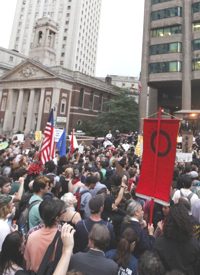
The ideologies and demographics of the Occupy Wall Street movement have been obscured by disorganization and media rhetoric, but emerging surveys and analyses are attempting to decipher the defining attributes of the rooted crowds in Manhattan’s Zuccotti Park and in other cities across the country. Who are these protesters? What are their political ideologies? Are they educated? Do they have jobs? In a poll conducted by Costas Panagopoulos, a political science professor at Fordham University in New York, a team of 15 researchers ventured out to survey 301 New York protesters to find the answers to these questions.
“Weve had a lot of speculation about who these people are,” the professor commented, adding, “Some of what we found reinforced what many already believed, and some results were surprising.” In the survey, Panagopoulos and his team focused on characteristics relating to the movements demographics and political beliefs to better understand the catchy, but somewhat esoteric, signs and slogans that have painted the media headlines over the past several weeks.
The poll, sponsored by Fordhams Center for Electoral Politics and Democracy, found that New Yorks OWS movement is 68 percent white and 61 percent male. While 28 percent of the protesters are unemployed, most are college graduates and 22 percent hold advanced college degrees. Of those who are currently employed, 30 percent claim to work full-time and 18 percent work part-time.
The average age of the protesters is significantly higher than the surveyors predicted. “We thought it would be mostly people in their 20s,” said Panagopoulos, but the average age is 33, which “means for every college student you have a mid-career professional in their 40s.”
Of the participants, 60 percent voted for Barack Obama in 2008, but 73 percent said they disapprove of the way he is currently handling the White House. Only two percent of the protesters voted for John McCain and a resounding 27 percent avoided the ballot box altogether.
Predictably, given one common theme throughout the OWS movement that is, a growing distaste for corporatist politics 97 percent disapprove of the performance of Congress, a relatively consistent trend of the American population as a whole. But although the general consensus is opposition to the current administrations performance, 42 percent of the protesters confirmed that they will vote Democrat for the U.S. House seat in their district, while only 4 percent said they will vote Republican.
“There seems to be a surprising confidence that Democrats will be responsive to their concerns, despite the fact that a Democrat has been in the White House during the past three years as all this has built up,” said the professor, noting that 78 percent of OWS protesters believe the economic recession has deepened this past year.
Although many of those surveyed declined to identify with a political party, “the group is very liberal and part of the Democratic base,” Panagopoulos postulated. “But a surprising number dont plan to vote.” Thinking ahead to the 2012 presidential contest, 25 percent said they will withhold their vote, while 36 percent said they will vote for Obama and a mere 3 percent would vote for the Republican nominee. According to the poll, the OWS movement overwhelmingly opposes the Tea Party, with 75 percent giving its so-called “rival movement” a thumbs-down rating.
More predictably, nearly 40 percent of those surveyed said they do not identify with a specific political party, but the percentage of protesters who lean to the right side of the political isle is exceptionally low, with only two percent supporting the Republican Party and not a single participant supporting the Tea Party. About 25 percent identified with the Democratic Party, and 11 percent identified with the Socialist Party and also 11 percent with the Green Party. When surveyed on their political views, 80 percent identified as “slightly liberal, liberal, or extremely liberal,” while only 6 percent identified as “slightly conservative, conservative, or extremely conservative.”
Although the participants held a unifying theme in some areas, a concrete political ideology was not fully clear at least, not as uniform as the Tea Partys small-government, Constitution-driven creed. All in all, Professor Panagopoulos concluded that the Occupy Wall Street group is largely a movement of “disgruntled Democrats.”



